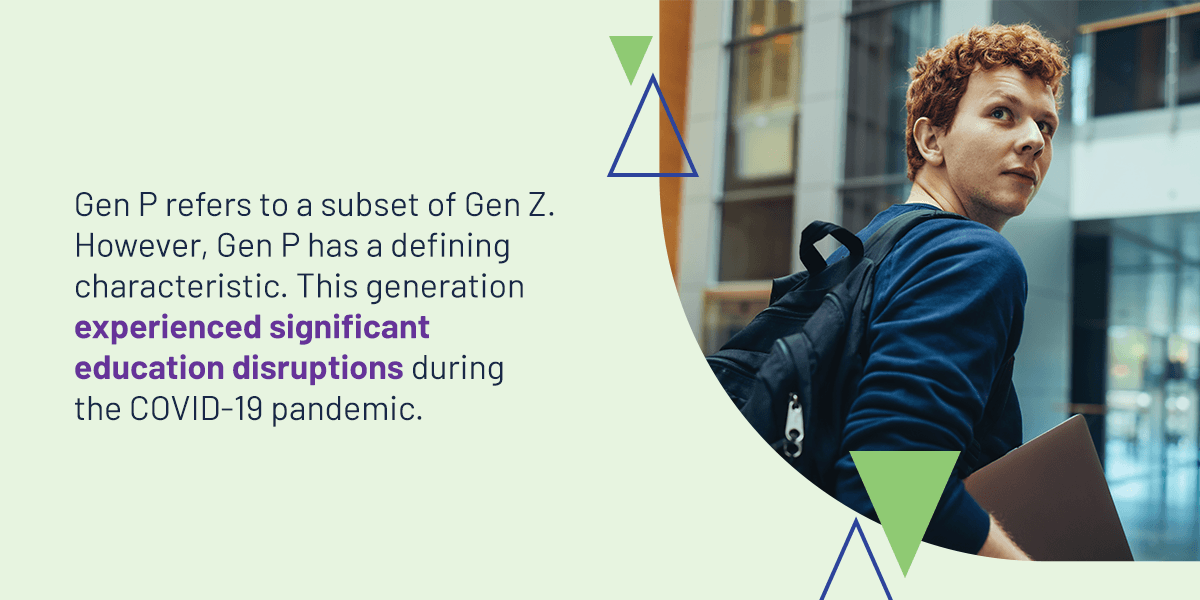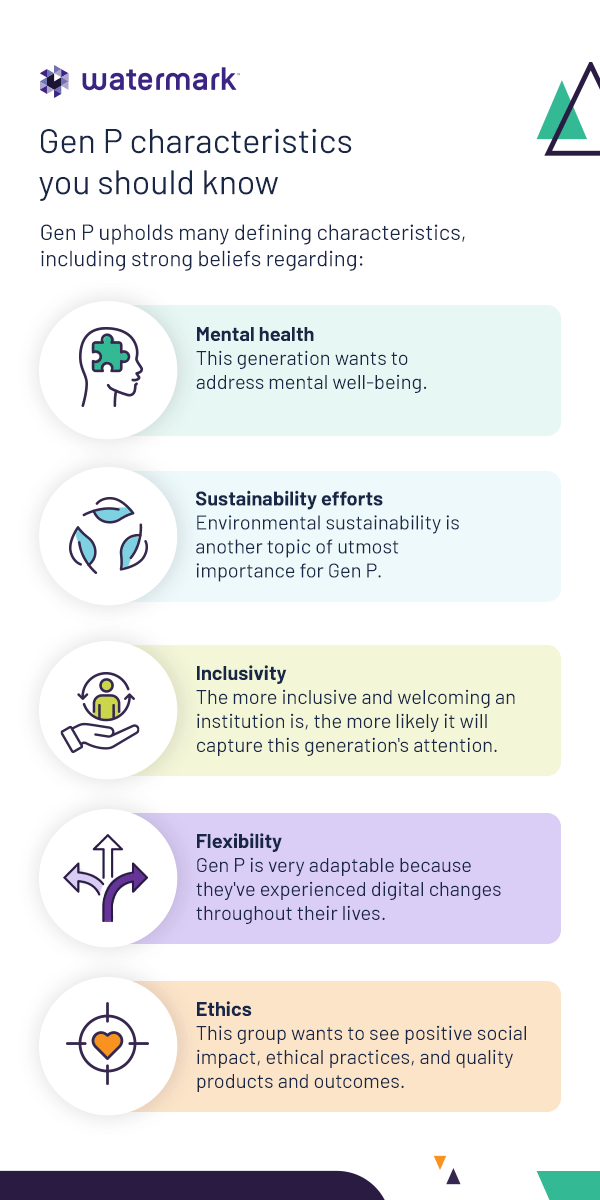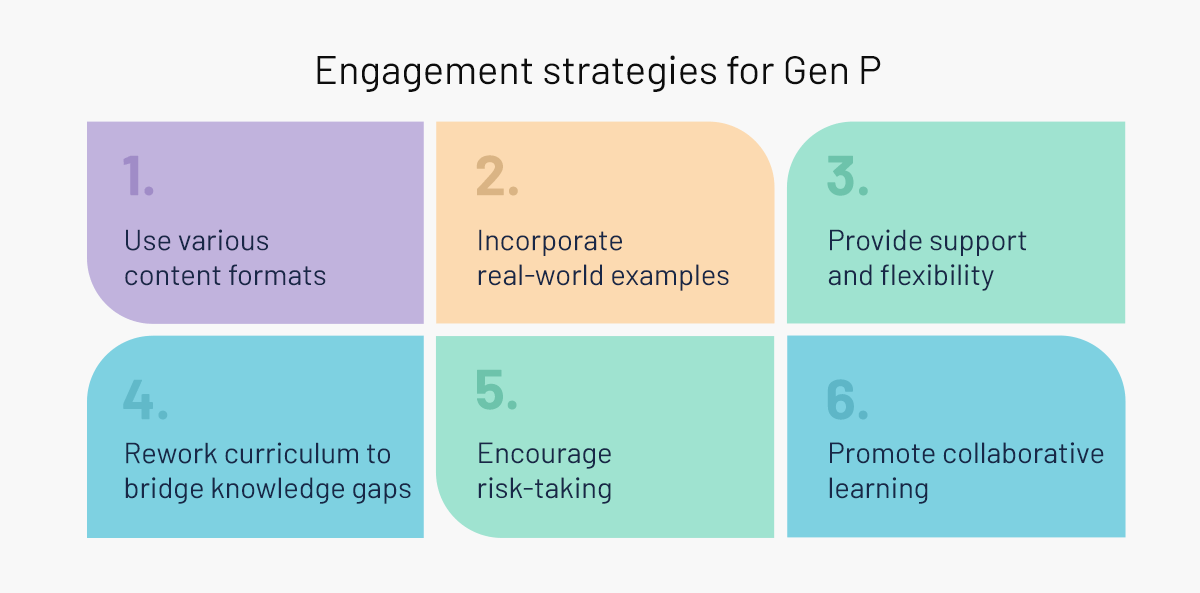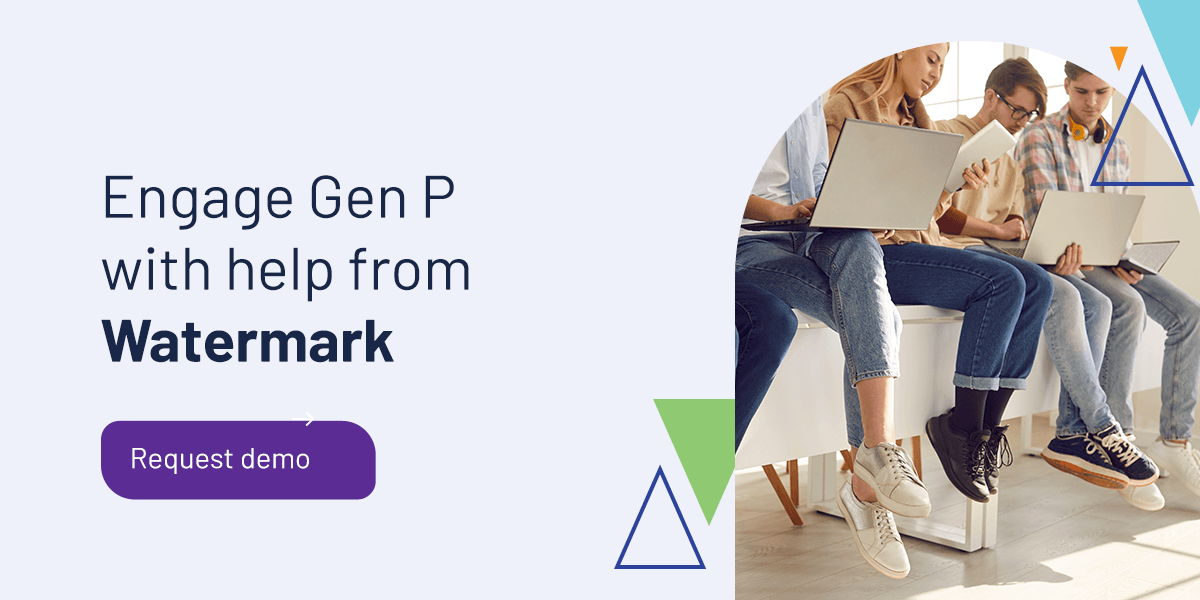



Each generation has unique characteristics and traits that help define their actions and values. As the upcoming class of high school graduates prepares to enter the higher education landscape, academic institutions must adapt recruitment approaches and engagement strategies to meet the expectations and needs of these students.
Generation P, better known as Gen P, has distinctive learning preferences, and they’ve experienced academic circumstances like no other era. Learn more about Gen P’s academic expectations and how your higher education institution can implement strategies to boost engagement and student success below.
Defining each generation by finite terms is challenging — some suggest specific years as generational cutoffs, and others use shared experiences to recognize people as part of a specific group. Gen P refers to a subset of Gen Z, which means they were born around or between 1997 and 2012. However, Gen P has a defining characteristic. This generation experienced significant education disruptions during the COVID-19 pandemic.
High school students, in particular, faced prolonged disruptions impacting and interfering with several crucial moments in their academic careers, such as graduation, state testing, and college touring. Although the pandemic affected people all around the globe, this generation faced uncertainty during vital developmental years. As classrooms shifted to a virtual setting, many students became comfortable in a flexible environment that lacked structure.
Additionally, many students were in a waiting or experimental period as schools tried to adjust to the new virtual demand. Some institutions had the technology to deliver a worthwhile academic experience, but others had to navigate challenges involving delivering devices to students, setting up internet connections, and working with teachers to craft engaging virtual learning experiences. For these schools and students, the shift to virtual learning was lengthy, with trial and error.
These significant disruptions changed the academic landscape and shifted student behaviors and expectations. It should come as no surprise that this generation differs in several ways from past learners. As your institution prepares to welcome Gen P on campus, it’s essential to alter your approaches and adopt a supportive culture that meets their needs.
Gen P shares many similar values as the rest of Gen Z, having experienced many of the same cultural shifts and technological advancements. Those born during this time are part of the first generation to experience the internet for their entire lives, never knowing how to navigate life without it.
This group has always had the world at their fingertips, allowing them to become highly collaborative and develop a pragmatic attitude. Gen P values authenticity and is quick to voice a need for change. They are outspoken and opinionated, wanting to see the institutions and organizations they invest their time, money, and energy in reflect their views.
Understanding and responding to pivotal concerns will be one of the best ways to engage with Gen P and provide them with worthwhile campus experiences. Gen P upholds many defining characteristics, including strong beliefs regarding:
The above characteristics of Gen P can certainly impact your institution’s recruitment and engagement strategies. However, there are also some education-specific expectations that you should be aware of. Understanding these vital elements and making the necessary adjustments to address concerns is the best way to attract and retain these students.
Gen P’s academic experiences and attitudes will impact your institution’s student engagement efforts.
The pandemic brought an influx of virtual experiences. While digital opportunities can empower people to gain new experiences they may not otherwise have access to, there is still a need for in-person events and activities. Gen P is eager for physical engagement with peers, educators, and industry leaders.
In-person course offerings, campus events, and similar experiences can satisfy this craving and improve the student experience.
The COVID-19 pandemic disrupted society in many ways, but Gen P students were majorly affected by losing critical developmental and educationl opportunities. Many students faced learning challenges when digital experiences overtook the nation, with some going weeks or months without academic interaction. The impact of these changes contributed to the largest decline in assessment scores since 1990.
Gen P students face a learning gap, unlike any other group of higher education students. Institutions can support Gen P by offering personalized advising, remedial programs, and at-risk student alerts. A comprehensive mentor program can help students identify their opportunities for improvement and provide a one-on-one experience for overcoming challenges.
Remedial programs can provide essential knowledge or skills students need to succeed, and alert systems can help your institution evaluate student risk to ensure your staff intervenes at pivotal moments to get students back on track.
Although Gen P wants in-person experiences, there is still room for virtual learning opportunities. Gen P appreciates the flexibility of online learning, but they have high expectations for these digital experiences. Students expect seamless interactions on easy-to-use platforms.
Gen P is comfortable with digital tools. They expect solutions in academic settings that empower convenient learning, allowing them to seek personalized success paths and innovation.
Implementing the right technology, crafting tailored experiences, and digitizing processes for efficient task completion can engage students digitally and provide the support they need to succeed.
One of the most concerning issues facing academic institutions is Gen P’s doubts about the value of higher education. Studies anticipate college enrollment to remain stagnant or decline over the next several years because current high school students see less worth in higher education or struggle to justify the costs of attending school.
Some students question whether postsecondary education can adequately prepare them for their future careers, and others dislike the proposed timeline for reaching graduation. Addressing these concerns will be challenging for many higher education institutions, but delivering specialized resources and opportunities may attract some Gen P students.
Tailored career programs can help students see the value of the educational programs you offer, and highlighting your available resources can demonstrate how your college or university can align students with their goals while empowering success.
Another significant shift in Gen P is neglecting the “traditional” educational timeline. While many previous graduating classes started college searches in their sophomore or junior year of high school, Gen P seems to be waiting.
Some students are delaying campus visits until as late as their senior year, possibly postponing until they receive acceptance or a substantial financial aid package before committing to travel.
Higher education institutions need to be more flexible in their marketing approach to attract these students. With less predictable search times, developing an extensive outreach can be beneficial for highlighting unique academic resources and encouraging students to get the ball moving.
Recognizing Gen P’s expectations is only part of the equation. Your institution must develop effective engagement strategies for attracting, enrolling, and retaining these students.
Check out the helpful strategies for enhancing engagement below.
A varied learning experience will be more engaging for Gen P students. Mixing hands-on activities, lectures, collaborative group work, and online modules can keep courses interesting and empower students to find meaningful ways to learn. Expanding your educational opportunities can also highlight your commitment to a diverse and flexible environment, allowing Gen P students to see your institution aligning with their values. Instructors can also evaluate student success using varying methods to determine which strategies are most effective to integrate into future courses.
Gen P students can benefit from leveraging real-world examples in their educational content. With so many students questioning the value of higher education, highlighting valuable connections between your academic offerings and possible career paths can reinforce the need for continued learning.
Real-world examples iterate the relevance of class content and allow students to gain firsthand experience in unique ways. Practicing career-needed skills, visiting operational facilities, and encouraging students to gain experience through internships and similar opportunities can further bridge the gap between education and experience.
Incoming learners have unique educational experiences compared to other generations. Some high schools handled virtual learning differently, giving students varying levels of digital experience and support. Student may have vastly different experiences than others in their graduating class.
Maintaining flexibility can highlight your commitment to student support and enable learners to access the tools they need to navigate blended learning models and varying formats.
Combining in-person and online learning opportunities can create a flexible environment that empowers students to learn meaningfully without missing information or being confined to a rigid schedule. Resources such as advising, mentor programs, counseling, mental health services, and writing centers can support students in overcoming new academic challenges.
Higher education institutions should anticipate a larger gap between upcoming Gen P students and previous groups starting their first year of higher education. You can use assessments at the beginning of the year to discover what students know and where they need to gain more experience. Instructors should not grade these assessments but rather use them to determine a foundation for the course. Your institution’s departments can then work together to build curriculum maps.
Implementing effective curriculum mapping strategies can make this process easier while ensuring students learn more, have access to vital technological tools, and feel confident. Your instructors will also be able to fill the gaps in learner knowledge to accommodate their classes better.
Risk-taking is fundamental in higher education. Diverse experiences and new ideas empower students to interact with alternative perspectives and gain more enriching experiences. An emphasis on risk-taking in the classroom is essential for promoting critical thinking, moral-ethical development, life-long learning, and innovation.
Encouraging these actions promotes experimentation and allows students the opportunity to persevere if they fail. Peer-based learning, note sketching, and speaking up during class are simple actions instructors can encourage in the classroom.
Gen P is very collaborative, so offering group work and unique interactions can be an excellent engagement strategy. Along with meeting the interactive needs of Gen P, collaborative learning delivers several other benefits. This strategy prepares students for life after graduation, increases retention, boosts self-esteem, encourages deep thinking development, and enables students to model leadership skills and time management.
Collaborative teamwork can appear in a variety of assignments and formats. From online discussion posts and team projects to group labs and other hands-on activities, students can interact with peers and instructors for a more engaging experience.
Supporting your students begins with finding a comprehensive solution. Watermark empowers higher education institutions to maximize student success and retention. Our suite of solutions has everything you need to transform your current processes and drive lasting progress.
Watermark Student Success & Engagement leverages real-time student data, predictive analysis, and a user-friendly platform to deliver a comprehensive solution for higher education institutions. Administrators and decision-makers can utilize this solution to support prospective students from the very beginning of their academic journey. It also completes our Educational Impact Suite, which colleges and universities can use to support faculty, build and manage curriculum, obtain valuable feedback and insights, and more.
Ready to welcome Gen P to your campus? Request a demo from Watermark to get started today.
























































































































































































































































































































































































Submit this form to schedule a meeting with one of our reps to learn more about our solutions. If you need customer support instead, click here.



